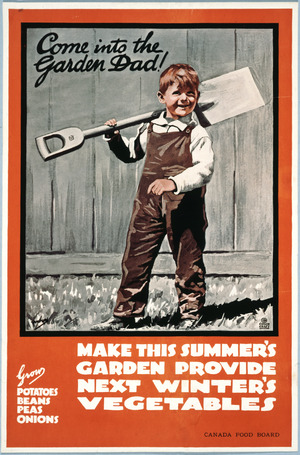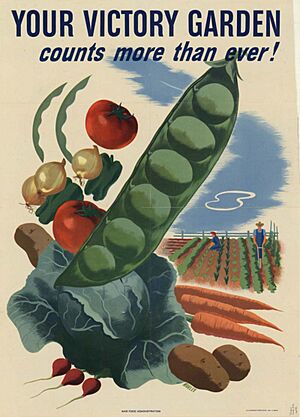Victory garden facts for kids
Victory gardens, also known as war gardens or food gardens for defense, were special gardens grown by people at their homes and in public parks during World War I and World War II. These gardens were planted in countries like the United States, United Kingdom, Canada, Australia, and Germany.
During wartime, governments encouraged people to grow these gardens. The main reasons were to help people get more food when supplies were low and to make everyone feel like they were helping the country. These gardens helped reduce the pressure on food supplies, working alongside rationing stamps and cards. Growing a victory garden also made people feel proud and useful, knowing their hard work was helping the war effort. It became a big part of daily life for families at home.
Contents
Victory Gardens in World War I
Canada's War Gardens
Victory gardens became popular in Canada in 1917. The government's Ministry of Agriculture started a campaign called "A Vegetable Garden for Every Home." People in cities and towns used their backyards to grow vegetables for their families and to help the war effort.
In Toronto, women's groups brought expert gardeners to schools. They wanted to get children and their families excited about gardening. Besides growing vegetables, people were also encouraged to keep hens in their yards for eggs. This led to a lot of potatoes, beets, cabbage, and other important vegetables being grown.
United States' War Gardens
In March 1917, a man named Charles Lathrop Pack started the US National War Garden Commission. They launched a big campaign to encourage war gardens. During World War I, food production had dropped a lot, especially in Europe. Many farmers had joined the army, and farms were damaged by fighting.
Pack and others thought that people could grow much more food without using land or workers already busy with farming. They also wanted to avoid using transportation that was needed for the war. The campaign encouraged people to grow gardens on private and public land. This resulted in over five million gardens across the U.S.
The Food Administrator, Herbert Hoover, hoped to send 20 million tons of food to the war front. Even though the actual amount was less, the campaign was a huge success. By the end of the war, the food grown in these gardens was worth over $1.2 billion. President Woodrow Wilson famously said, "Food will win the war." To support home gardens, a United States School Garden Army was even started for school children.
Victory Gardens in World War II
Australia's "Dig for Victory"
In 1942, Australia's prime minister John Curtin started a "Dig for Victory" campaign. Food supplies were low because of rationing, dry weather, and fewer farm workers. This campaign encouraged homeowners all over Australia to grow crops to help the war effort.
The idea was very popular with both the media and the public. Many Australians already grew their own fruits and vegetables. The YWCA even created "Garden Army Week" to promote a new "Garden Army" focused on farming and growing crops. By 1943, the fear of invasion lessened, but home gardens continued throughout the war.
Britain's War Gardens
In Britain, the "digging for victory" movement used a lot of land. This included empty lots, edges of railway lines, and even fancy gardens and lawns. Sports fields and golf courses were taken over to grow food. Some schools, like Winchester College, used their fields to grow vegetables for their students.
By 1943, the number of allotments (small plots of land rented for gardening) had almost doubled to 1,400,000. These were in rural, urban, and suburban areas. C. H. Middleton had a radio show called In Your Garden. Millions of listeners tuned in for advice on growing potatoes and other vegetables. This helped people feel like they were all working together for the war.
People planted victory gardens in their backyards and on apartment rooftops. Sometimes, empty lots were used as cornfields or squash patches. In London, parts of Hyde Park, London were plowed for gardens to promote the movement. Even Buckingham Palace and Windsor Castle had vegetable gardens planted by King George VI to help with food production.
People used natural ways to fertilize their gardens. They collected soot from chimneys, lime mortar from bombed buildings, and wood ash. They also made compost piles from lawn clippings, kitchen scraps, and even animal waste. This helped their plants grow strong and healthy.
United States' War Gardens
During World War II, the United States Department of Agriculture encouraged people to plant victory gardens. About one-third of all vegetables grown in the United States came from these gardens. Americans were told that the food from their gardens would help lower the cost of vegetables needed to feed the troops. This would save money for other military needs. One poster said, "Our food is fighting."
By May 1943, there were 18 million victory gardens in the United States. Twelve million were in cities, and six million were on farms.
Eleanor Roosevelt planted a Victory Garden on the White House lawn in 1943. This was a message to show that gardening was a patriotic duty. While many saw it as patriotic, 54% of Americans said they grew gardens for economic reasons, meaning to save money on food.
Even though the Department of Agriculture at first worried that victory gardens might hurt the food industry, they later shared gardening tips. These tips appeared in booklets from the Department of Agriculture and from big farming companies. In 1944, the fruits and vegetables harvested from home and community gardens were estimated to be equal to all the fresh vegetables grown by commercial farms.
The Victory Garden movement also tried to bring communities together. Local areas held festivals and competitions to show off the produce people grew. However, not all communities were united. For example, at some harvest shows, separate prizes were given to "colored people" in similar categories. This showed that not everyone was treated equally.
In New York City, the lawns around a place called "Riverside" were used for victory gardens. Parts of San Francisco's Golden Gate Park were also used. The slogan "grow your own, can your own" became popular. It meant families should grow their own food and then preserve it in jars.
During the war, artist D.H. Bedford created a brochure called "ABC of Victory Gardens" for the United States Department of Agriculture. This brochure taught Americans everything they needed to know about gardening. It helped increase crop production from victory gardens, which was important because food shortages were a real problem.
In Japanese Internment Camps, government officials also encouraged Victory Gardens. This was to help people be self-sufficient and save resources. People who were farmers before being interned started growing vegetable gardens inside the camps. For Japanese people, these gardens were not about patriotism. Instead, they provided fresh vegetables to add to their government-issued meals and offered foods that reminded them of home.
Claude Wickard, the U.S. Secretary of Agriculture, said: "A Victory Garden is like a share in an airplane factory. It helps win the War and it pays dividends too."
After the War
After the war ended in 1946, many British people stopped planting victory gardens. They expected food to be more available. However, shortages continued in the United Kingdom, and rationing stayed in place for some foods until 1954.
Some victory gardens from World War II still exist today. The Fenway Victory Gardens in Boston, Massachusetts, and the Dowling Community Garden in Minneapolis, Minnesota, are two examples. Most plots in the Fenway Victory Gardens now have flowers, but the Dowling Community Garden still focuses on vegetables.
Since the early 2000s, interest in victory gardens has grown again. New victory gardens have appeared in public spaces, and websites and blogs promote them. There are also calls to bring back a national campaign for victory gardens. In March 2009, First Lady Michelle Obama planted a "Kitchen Garden" on the White House lawn. It was the first since Eleanor Roosevelt's, and it helped raise awareness about healthy food.
Films and Television
Many countries made films about growing victory gardens to share information.
- Canada (World War II): He Plants for Victory (1943)
- United Kingdom (World War I): Grow Vegetables For War Effort, War Garden Parade
- United Kingdom (World War II): Dig For Victory! (1940, 1941, 1942), Children's Allotment Gardens (1942)
- United States (World War II): Victory Gardens (1941, 1942, 1943), Barney Bear's Victory Garden (1942)
Television shows have also shown victory gardens. For example, Wartime Farm showed modern families living in a recreated wartime setting, including digging victory gardens. The TV series The Victory Garden also promoted composting and growing vegetables at home.
The 1975 TV show The Good Life showed a couple trying to live off their land. They turned most of their garden into a vegetable patch and even had a chicken coop. The main character, Tom, would tell his neighbors, "We're digging for victory!" even though the war was long over.
Images for kids
-
Victory garden in Ontario, Canada
See also
- Community garden
- Home front during World War II
- Rationing in the United Kingdom
- United States home front during World War II








